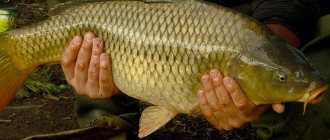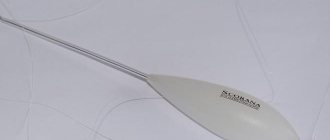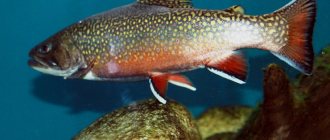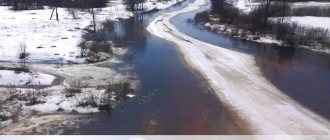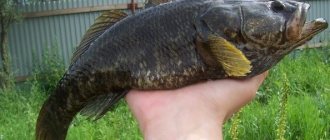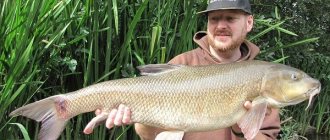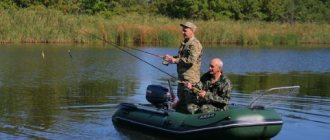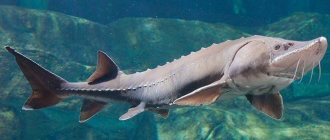Habitats
Smelt is a fish that lives in Lake Ladoga, the Baltic Sea, the Gulf of Finland, Lake Onega and in reservoirs in the northern part of Russia. Thanks to excellent acclimatization, European smelt can descend into the Kuibyshev, Saratov, Gorky and Rybinsk reservoirs. The fish lives quite a long time - about three years. Its weight averages six to eight grams.
Beneficial features
Smelt fish is recommended for consumption by people suffering from diseases of the heart, skeletal system and blood vessels. The composition contains a balanced amount of vitamins and beneficial microelements. Almost twenty percent of fish consists of easily digestible protein. The composition contains magnesium and phosphorus, calcium and potassium, molybdenum and iron, nickel and sodium, which are essential for humans.
Experts have proven that smelt fish (constantly or periodically eaten) will provide reliable protection for the nervous and muscular systems, help avoid problems with blood vessels, hormonal levels and high levels of insulin in the blood. Smelt normalizes the functioning of the digestive tract, improves the functioning of the heart, brain, lungs, relieves swelling and reduces inflammatory processes.
Leonid Pavlovich Sabaneev
Rice. 91.A – supply trough; B – lift; C1, C2, C3, C4, C5 – peepers;
D, D1 – outpost ice hole; E, E1 – trough (lifting); aa1 – raise the corner;
bb1 – middle angle; CC1 – residual angle.
nok), that is, hatched in the same spring, and herds of young smelts until late autumn are always surrounded by small perch, following them everywhere and finding constant food for themselves in the backward and weak; The perch cannot get into the middle of the herd. According to the same Vasiliev, the perch leaves the smelt when the latter outgrows its pursuer. For fishermen of Lake Pskov, the absence of perch between smelts is a sign of their maturity, and mixed catches are valued very low. In general, the reproduction of smelt depends both on the spring winds, which throw their eggs ashore, and almost more on the harvest of perch, which, as mentioned above (see “Perch”), is greatest during spring winds. According to the observations of Mr. Grimm, in the years of a bountiful harvest of oysterfish, young smelt is not caught at all, since all of it is prey for perches, and greatly multiplied perches can even completely destroy all smeltfish in the lake. So, for example, in Pestovskoye Lake of the Nikolsky fish hatchery (Novgorod province, Valdai district), the latter completely disappeared in 1865 due to too economical fishing in general, and in particular perches, and they spread here again only in 1875, after they came here By 1872, 5 pounds of smelt were transplanted from Lake Velje. Smelt is also consumed in large numbers by water birds, especially seagulls, and the accumulation of these birds in a certain place serves as an indicator of the location of the fish. In addition, one must always keep in mind that in windy weather flocks of smelt always gather in the quiet area, that is, on the leeward shore.
Smelt fishing is carried out, for example, in Beloozero throughout the year almost without interruption, but in Lake Peipus winter fishing is insignificant, probably because here the smelt goes to winter in the deepest places. Recently, spring fishing is no longer practiced everywhere, since even the fishermen themselves [5] are beginning to come to the conclusion that fishing during spawning reduces the number of autumn and winter catches, which produce fish that are more valuable and have a wider market. Spring fishing was previously carried out in Lake Pskov, mainly at the mouth of the Velikaya River, with seines about 200 fathoms in length with a caster of up to 5 fathoms. Almost the same seines are used to catch fish during spawning at the mouths of Sheloni and Lovat, on lakes Ilmen, Kovzhi and Kema, on Beloozero, but here, in addition, they scoop out a large number of fish with frequent nets, like a basting net. Summer fishing usually begins on August 1 (Pskov Lake) or on Ilyin’s Day (Ilmen); Fishing with small-mesh seines with more than 3 cells per inch on Lakes Peipsi and Pskov from June 24 to August 1 is prohibited by law and these seines are selected and sealed, just like drying nets. Autumn fishing is considered from September 8 until freezing, winter - from freezing of the Lake until it opens. The largest amount of smelt is caught, of course, in winter, and since seine fishing under ice is done completely differently than in summer and autumn, and is known to very few, I will give here a description of this fishing in Lake Pskov, which in general, except for the names of terms, is known to few only differs from winter seine fishing in other Russian lakes and rivers.
To catch smelt, a large seine (stock) is used at this time, consisting, as always, of two wings and a skein (uterus), only these parts of the seine have more frequent meshes than for catching other fish. Both the uterus and the wings are knitted from several parts of different knitting and bearing special names. The entire seine is up to 300 fathoms long; its width is from 8 to 10 fathoms, and the uterus is up to 10 fathoms long, with a width at the mouth of up to 7; its cost ranges from 700 to 1000 rubles. To transport a seine, at least 6 horses are required, and therefore winter fishing begins when the ice is sufficiently strong. It is produced in the following order. First of all, a large hole is made, the so-called. a supply trough, 3 arshins long and ¾ arshin wide; Parallel to it, at a distance of 200 fathoms, another ice hole is made, an outpost, or simply a trough, 2 fathoms long and 2 arshins wide. The first hole is used to lower the seine, and the last one is used to pull it out. At a short distance from the first hole, in a parallel direction, a small hole, called a lift, is made to untie and straighten the uterus. In front of the trough, a narrow ice hole is made - an outpost to prevent the return passage of fish from the net. Between the lift and the outpost ice-hole, several small holes are cut, called peepers; through these holes, one after another, they observe whether there is fish under the ice, for which they lie down on the ice, covering their heads with something [6]. To transport the seine, very large sleighs are used, up to 2½ fathoms long and up to 2½ arshins wide.
The seine itself is thrown in the following order: into the first hole or trough A, on both sides under the ice, it is lowered along a pole up to 15 fathoms long, one opposite the other in a straight line, towards aa1; Iron rings are attached to the ends of the poles, to which ropes are tied to pull the net, each at least 100 fathoms. In the direction of the pole in either direction, 43 steps are measured and a small hole is cut into which an arched wooden hook is lowered, which grabs the pole located under the ice and drives it further with an iron fork called a soshala. Next, several more similar holes are made and the pole is driven in the same exact way over a distance of 100 soots. from the giveaway trough. The same is done on the other side of the large ice hole. From the end holes aa1, ropes attached to poles are removed and three horses are harnessed to each end or tied to a cylinder gate, called a barrel, due to its resemblance to it, and placed on a sled attached to the ice. In this way, the wings of the seine, lowered under the ice, are dragged to the end holes aa1. After this, the pole turns at a right angle in the direction where it is intended to pull out the seine, i.e., towards the outpost and the lifting trough. This turn is called either the first corner, or rosstan. From here the pole is driven under the ice in the same order at a distance of 100 fathoms, where an ice hole is made, called the middle corner, where the seine is also pulled up. The last hole CC1, which should be in a straight line with the lifting trough, is called the remaining angle. From here the pole turns towards the trough, and the net is brought down on both sides. Here, in the trough, he is pulled out by hand. Winter seine fishing requires a larger number of workers (16 people) and is much slower than summer and autumn.
In Lake Pskov, most of the caught smelt is sold to prasol buyers and goes to snow drying plants[7], but in other places it is dried only in summer and autumn, and winter smelt is sold frozen. The best dried smelt is Talabsky, yellowish in color, and of the ice creams, the most valuable is the large and white Belozersk smelt. It is dried in large ovens, specially built for this purpose, and dried to varying degrees, depending on whether short-term or long-distance sales are in mind. One is called semi-dried, and it comes out of a pound of fresh fish, 30 lbs., the other is called dried, and it comes out from ¼ to ½ a pound. Typically, drying is carried out as follows: the heat in the oven is raked, the middle is sprinkled with clean sand or salt, and then the smelt is carefully placed in rows (with a shovel), in a layer of 2 fingers, and salt is also sprinkled on top. After making sure that the smelt is dry enough on the bottom side, turn it over to the other side, also with a shovel. The main skill of the master is not to over-dry or under-dry the fish.
A good master receives 8 kopecks for each landing. and makes up to 40 landings per day. Each planting contains three to four quarters of smelt and 12½ pounds of salt, and from the oven, depending on drying, the result is from 1 pood to 30 pounds. up to 2 p. 30 f. From the oven, the smelt is poured into barns, and then packed into baskets and sold. Sometimes, for a better smell, the smelt is sprinkled with Provençal or caraway oil. At Ilmen they dry it very dry, so that only 10 pounds come out of a fresh pound, but they don’t sprinkle it with salt.
Smelt, especially dried, partly frozen, has a very extensive sale and, comparatively, a very high cost. Pskov and Belozersk smelt goes to the most remote areas of Russia and is bought locally (from buyers) from 3 to 5 rubles per pood, depending on demand, number of catches and time of year. It is cheapest during short spring fishing, when there is no time to dry it and the smelt soon spoils. Then they buy it fresh (from catchers) for no more than 30 (sometimes 15 and 10 kopecks) per quarter, i.e. half a pood.
It is difficult to determine how large the amount of smelt produced in the northwestern part (partly in the north) of Russia is, but, in any case, it is most produced in Lake Pskov, from which annually (according to information collected by Vasiliev) from 150 to 300 thousand pounds of one dried smelt. According to other sources[8], some Talab merchants annually sell up to 100 thousand barrels (or 50 thousand quarters) of smelt to St. Petersburg, Moscow, Kiev and Warsaw, and the entire catch is considered to be about 400 thousand pounds of dried. In Beloozero, according to Danilevsky, the total catch of smelt can be taken at 30-40 thousand poods. In general, we probably produce up to two million pounds of raw smelt - this is the smallest fish of all used for human food.
This important economic importance of smelt is explained both by its abundance and speed of reproduction, and by its even higher qualities. Possessing a large amount of fat, the smelt provides a cheap and nutritious food, and one pound (dried) is enough to make soup for 10 people, and the raw one makes a very rich fish soup. Fresh smelt, just taken out of the water, has a transparent bluish color, so that its insides are visible, and has a very heavy smell, similar to the smell of smelt, even stronger; but having fallen asleep, the smelt turns white, and this smell gradually weakens, and the dried fish almost loses it.
Well-dried Pskov smelt has a grayish color, while Ilmen smelt is yellowish. The large Belozersk frozen smelt is especially famous for its taste, which is why it is valued relatively more than others.
It is more than likely that over time the commercial value of smelt will increase significantly, since there is no doubt that it reproduces most successfully where large fish are almost caught. Thus, many lakes face the same fate as Lake Pskov, which has been home to perhaps the most intensive seine fishing for a long time, due to the convenience of this fishing. One can even say that breeding smelt in the heavily fished lakes of Central Russia would be very desirable, in any case more desirable than breeding, for example, trout and whitefish - fish that are incomparably more demanding and yet, despite their value, much less important than smelt. In shallow (although not particularly shallow) and feeding pools, smelt could profitably take the place of pike, perch, roach and other relatively cheap lake fish that have some value only in fresh form, especially the place of completely worthless top fish. It would be most convenient and expedient for the first time to take care of breeding smelt in Lake Rostov and, perhaps, in Lake Pereyaslavl, where, however, smelt is unlikely to find particularly favorable conditions, since it is not one of the feeding lakes. From here the smelt could be transplanted into the Chukhloma and Galich lakes. Unfortunately, smelt spawns in the spring and its eggs can hardly be transported over long distances as easily as winter salmon eggs.
I believe, however, that in winter it will not be difficult to deliver a sufficient amount of adult smelt (10-20 pounds) to Rostov by rail (from Novgorod province) in large barrels, and it would not hurt the Rostov zemstvo to keep this in mind. Smelt, like smelt, is a very tenacious fish and, if not crushed and carefully removed from the net, can undoubtedly withstand longer transportation than, for example, perch and pike. It goes without saying that for a fisherman-hunter, smelt can only mean a good bait for fishing perch.
Notes
[1] According to modern classification – Osmerus eperlanus morpha spirinchus Pallas. (ed.)
[2] It is in lakes Shchuchye and Velest (see “Materials for Geography and Statistics of Russia”).
[3] In Lake Galich (Kostroma province) there is no real smelt, and this name is given to juvenile perch and ruff. In the “Guide to the Volga”, compiled by Kuchin (1870), there is news that on the Lunda, one of the tributaries of the Vetluga, there is a small lake Nestiar, in which smelt appear periodically, interspersed with pike and perch, which destroy them. Maybe these are not smelts, but caps (Lencaspiuc) or even lake minnows.
[4] “A brief sketch of Pskov (Talab) Lake.” Pskov, 1879, pp. 17‑18.
[5] At the end of 1879, fishermen of Aleksandrovsky Posad, the main fishing point on Lake Pskov, drew up a verdict on the destruction of spring smelt fishing (“Vesti. Pskovsk zemstvo”, 1890, No. 7).
[6] This method of looking for fish under the ice should be kept in mind by all winter anglers, who often waste time completely in vain, making holes in vain and placing gear (fillies) in places where they would not see a single fish.
[7] On Lake Pskov, according to the latest information, there are 83 operating factories with 554 furnaces.
[8] See “Pskovsk. lips Ved.,” 1879, No. 14. Over the last five years (from 1883 to 1887), an average of about 240 tons of dried smelt was exported from Pskov via the Warsaw Railway, i.e., up to a million pounds of raw smelt.
Fishing Features
Smelt is a fish that does not have to be purchased in grocery stores. You can easily catch it with your own hands. Smelt fishing becomes especially active with the onset of cold weather. In the central part of the country, for example in the Gulf of Finland, fishermen go out on the ice already in early December. Active biting occurs precisely in winter. At this time, you can catch about five kilograms of fish, which will number about four hundred pieces.
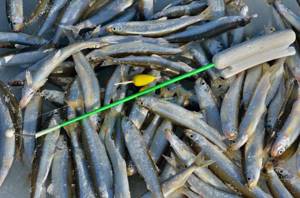
Of course, catching European smelt requires a certain dose of patience, perseverance and skill. But believe me, the result is worth spending time on. Smelt is a fish whose cooking recipes are very diverse. It can be dried and dried, salted and fried, smoked and baked in the oven.
When and how to catch smelt
Hunting for dwarf smelt can be carried out all year round, but is especially effective in spring (before and after spawning), autumn and winter. In the summer, there is enough zooplankton and other animal food in the water, which significantly reduces the quality and frequency of bites.
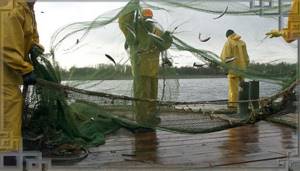
For commercial catching of smelt, nets are used, and sports and amateur fishermen prefer a float rod with thin tackle of 0.2-0.25 mm. Such a fishing line will allow you to feel the movements of a small fish well, but at the same time it is strong enough to withstand snags on aquatic vegetation and a heavy sinker of 30-60 g when fishing for smelt in a strong current. The leash is placed an order of magnitude thinner - 0.12-0.18 mm. Small hooks with a long shank are attached to it. The bait for smelt is bloodworms, worms, maggots, pieces of meat or fish, and burdock moth larva. It is common to catch large smelt using spinning tackle using the smallest spoons and wobblers.

Tackle "tyrant"
The largest catch of smelt occurs during the frosty season, when the fish gather in huge schools and come close to the shore in search of food. In winter, smelt is caught from the ice in holes using a jig or spoon, a float rod and a “tyrant”: a two-meter piece of fishing line with a sinker and short leads (3-15 pieces), to which flies or hooks are attached with the point up. Colored silicone, threads, and feathers are used as bait. The finished tackle is attached via a carbine to the main line of a no-kick winter fishing rod and lowered into the hole until the sinker touches the bottom. It is important to maintain vertical tension on the rig at all times.
To learn more:
Description of the trout fish - how is it useful?
Catching smelt with a tyrant is passive. The under-ice flow of water sways the leashes, which leads to twitching of the artificial bait. Such a simple game is enough for a hungry and voracious fish to greedily attack the hook and get hooked itself.
Using tackle with a float requires increased care and precision. Smelt, like bream, most often takes the bait from below and rises with it in the water column, which leads to sagging of the fishing line. If you do not make a sweeping hook in time, you may be left without a catch.
Soup
The simplest and fastest dish that can be prepared from a product such as smelt fish.
For this you will need:
- Two large potatoes.
- One onion.
- Celery root.
- Parsley.
- Black peppercorns.
- Salt.
- Bay leaf.
- A pinch of nutmeg (ground).
- Smelt fish and smelt are the same thing. We take the one that is in the store or that we managed to catch. In total, you will need about ten to fifteen pieces per two-liter saucepan of soup.
First, you need to prepare a flavorful and rich vegetable broth. To do this, pour one and a half liters of water into a saucepan, add peeled, diced potatoes, celery, and a whole onion. After the broth has boiled, add spices: bay leaf, black peppercorns (to taste), a pinch of nutmeg and the same amount of salt. Cook until the vegetables become soft. After this, turn off the heat and remove the saucepan from the stove. We take out the onion, bay leaf and celery - they have already played their role in the preparation.
Now it's the fish's turn. It needs to be washed, cleaned, and the head removed. Place in the broth and let it simmer for another ten to fifteen minutes. The soup is ready. Add some fresh herbs and a piece of butter before serving.
Fried smelt
Fried smelt fish is one of the most popular dishes. Preparation takes just a few minutes, but the result is surprisingly tasty and satisfying. So, to prepare this dish, you will need vegetable oil, a little salt, a couple of tablespoons of flour for breading, a frying pan and, of course, peeled and headless smelt.
After the fish carcasses are cleaned and washed, place them in a large container and sprinkle with salt, pepper and fish spices (optional). Mix thoroughly. Add flour and mix again. Smelt is a fish that does not need to be given too much attention. Breading every little fish is simply a waste of time.
Pour vegetable oil into a frying pan. Place the fish in even rows and fry on one side for three minutes. Then turn the carcasses over, cover the dish with a lid and fry the fish for another five minutes. Fried smelt fish is ready. The recipes and cooking descriptions are as simple and clear as the process of frying this fish itself.
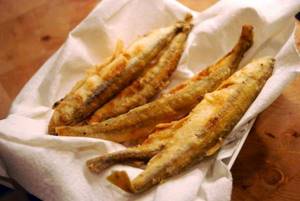
Appearance of fish
Where is vendace found?
Ichthyologists believe that the lake-river form of smelt arose as a result of natural disasters that did not allow the fish to return to sea water after spawning. The smelt remaining in fresh water bodies was forced to adapt to limited space and a meager food supply. After some time, the sea fish greatly changed its physiology and appearance. This is how a separate subspecies appeared, which was called “smelt”.
The distinctive features of smelt include:
- small size, which rarely exceeds 12 cm;
- a small adipose fin located on the back of the fish;
- elongated, spindle-shaped body;
- quite large head;
- lower jaw pushed forward;
- gray-green back, on which a triangular fin is located.
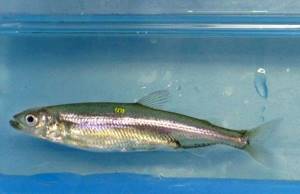
Smelt is easily distinguished from other representatives of the smelt family by its elongated lower jaw.
A description of the smelt would be incomplete without mentioning the smell of fresh cucumber that comes from this fish. The scales of the smelt are of medium size and do not sit firmly on its body. Small teeth are present not only on the jaws, but throughout the entire inside of the mouth. The largest smelt caught with amateur gear weighed just over 100 g and was 18 cm long.
Smelt in white sauce with onions
If you want a more original dish, we advise you to pay attention to the recipe, where a seemingly ordinary smelt turns into an exquisite product that is not a shame to serve on a festive table or treat unexpected guests.
In order to prepare such a dish, you will need to take the following products:
- Smelt – 10-20 pieces.
- Onions - one piece.
- A little vegetable oil.
- Salt mixed with black pepper or ready-made seasoning for fish.
- 300 ml milk or heavy cream.
- One bunch of fresh herbs (parsley, dill).
- A couple of tablespoons of flour.
- A little dry white wine.
Spawning smelt
The process of spawning involves sexually mature individuals, whose age is usually 2-3 years. A prerequisite for the full development of the masonry is not only a suitable water temperature, but also a constant flow of oxygen, which is possible during the flow. That is why smelt is sent to the mouths of rivers and streams to reproduce. Here the fish chooses shallow flowing areas with a sandy, pebble, rocky bottom, where it lays an average of 20-25 thousand tiny orange eggs with a diameter of about one millimeter. A special feature of the masonry is an additional jelly-like layer. Over time, it swells, bursts and turns into a sticky clot, which helps securely attach the egg to a pebble, vegetation, or driftwood. After 2-3 weeks, the fry appears and immediately begins to feed on zooplankton.
To learn more:
Muksun fish - structure, habitats, spawning
Smelt spawning lasts 3-4 days, occurs at night and is accompanied by loud noise and splashes. Peak spawning occurs at a water temperature of +6-9°C. During this period, the fish changes its color, which is clearly visible by its blue-black head and gill covers. Having completed the process of procreation, the freshwater smelt takes a short break to rest, after which it returns to its permanent habitat and begins active feeding.

How to cook
The onions will need to be chopped very finely. After this, fry it in vegetable oil until “blush” appears. Place the fried onions on a separate plate. Try to leave the oil in the pan.
Now you can move on to preparing the sauce. To do this, put a piece of butter in a frying pan and melt it over low heat. As soon as the butter changes its solid consistency to liquid, you can add flour. It is recommended to fry it for about two to three minutes.
As soon as the flour begins to change its white color to a darker shade, we begin to gradually pour in the cream (milk) in a thin stream. Arm yourself with a whisk and thoroughly mix all the ingredients in a frying pan. It is important that there is not even the slightest hint of unpleasant-tasting lumps in the sauce. Add a little sauce and leave it on low heat until it thickens completely.

It's time to cook the fish. The smelt must be cleaned, all entrails removed and the head removed. Now rinse the fish under running water and dry a little with a paper towel. Take a small saucepan (saucepan), put the smelt there and add fried onions and finely chopped greens on top. Pour half a liter of water and dry wine. Place the dishes on low heat and simmer until the smelt is ready.
We come back again with the sauce. To make it more aromatic and tasty, it is recommended to add a couple of ladles of wine and fish broth in which the smelt was cooked. Bring to a boil again, reduce the heat and wait for it to thicken. The resulting mixture can even be strained. Place the boiled smelt on a plate using a colander spoon and pour white sauce on top. Boiled rice will be the best side dish for such a delicious, but very simple and quick to prepare dish. The second option is to fry the smelt and then dip it in white sauce.

